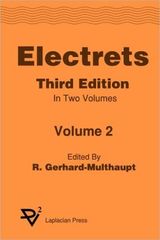
Electrets, 3rd edition, vol. 2
R. Gerhard-Multhaupt ed.
(1999) xviii +338 pages
Electrets have emerged as invaluable components in an ever increasing number of applications ranging from air filters to microphones. Volume 2 contains six chapters on the hot topics in electets providing a digest of the significant progress in electret research over the 11 years since the 1987 publication of the second edition. This volume 2 compendium is based on special issues of the IEEE Transactions on Dielectrics and Electrical Insulation, with extensive updates by each contributor.
This book would be of interest to the materials specialist, applications engineer, chemist, biotechnologist, and anyone interested in new materials for electronic products.
Editor's comments: These six chapters are based on the review articles in the IEEE Journal as noted above. The review articles have been thoroughly revised and updated. They deal with recent developments in these six areas of electret research. Since the historical background, the specific review literature, and the possible future developments are all discussed in the respective chapters, may it suffice to say electret research follows the trends toward ever smaller device applications, toward better understanding and control of the underlying molecular mechanismas, and toward increased use of optical waves, trends that are common to most fields of electrotechnology and materials science.
Publisher's Comments: Although there have been monographs and proceedings of conferences published on this topic, there had been no cohesive treatment of the entire field of electrets until the original publication of Dr. Sessler's seminal work, Electrets, first editon. Now he and his colleagues, plus younger colleagues who bring a fresh perspective, continue to contribute and update the series by offering this latest comprehensive survey of noteworthy develpments in the field of electrets.
We hope Electrets, 3rd edition, printed in two volumes, will continue the proud tradition of the former editions and be a commendable contribution to the literature of the field.
Contents
Space-Charge Electrets by R. Kressmann, G. M. Sessler and P. Gü nther
Introduction; New Electret Materials; Inorganic Materials; Thermally Grown Silicon Dioxide; Chemical Vapor Deposited Silicon-Based Layers; Multi-Layer Systems of Silicon-Based Electrets; Sol-Gel Silicon Dioxide; Organic Electrets; Methods for Measuring Charge Distributions; Thermal Methods; Acoustic Methods; Field Method to Measure Mean Charge Depth; AFM Methods; Charge Transport and Charge Decay in Different Electrets; Theoretical Work; Silicon-Based Electrets; Thermally Grown Silicon Dioxide; CVD Silicon Electrets; Sol-Gel Silicon Dioxide; Optical Discharge of Silicon Dioxide; Polymer Electrets; Teflon, PTFE, FEP, PFA, AF; Polyethyleneterephthalate (PETP); Polyethylene (PE); Polymethylmethacrylate (PMMA); Polyimide (PI); Polypropylene (PP); Other Polymers; Other Materials; Glass; Photorefractive Materials; Applications of Space-Charge Electrets; Acoustic Transducers; Air and Gas Filters; Radiation Dosimeters; Electret Coatings for Improved Solar Cells; Carrier-Lifetime Measurements; Data Storage; Further Applications; References
Distribution and Transport of Charge in Polymers by G. M. Sessler
Introduction; Methods for Measuring Charge Distributions; Thermal Methods; Acoustic Methods; Optical Methods; Experimental Results; Fluoropolymers; Fluoroethylenepropylene (FEP); Polytetrafluoroethylene (PTFE); Perfluoroalkoxy (PFA); Amorphous Fluoropolymer (AF); Polyethylene (PE); Polyimide (PI); Polypropylene (PP); Polyethyleneterephthalate (PETP); Polymethylmethacrylate (PMMA); Polyvinylidenefluoride (PVDF) and its Copolymers; Other Polymers; Conclusions; References
Piezoelectric Polymer Electrets by G. Eberle, H. Schmidt, B. Dehlen and W. Eisenmenger
Introduction; The PVDF Family; Structure of PVDF and P(VDF-TrFE); The Ferroelectricity of PVDF; Polarization Reversal and Stability; Switching Experiments; Nature and Origin of Trapped Charges; Thermal Stability of the Polarization; Applications; Odd Nylons; Vinylidene-Cyanide Copolymers; Polyurea; Other Polymers; Summary; References
Pyroelectric Polymer Electrets by S. Bauer and S. B. Lang
Introduction; Pyroelectric Polymers; Amorphous Polymers; Magnitude and Thermal Stability of the Pyroelectric Effect; Cyanopolymers; Photonics Polymers; Fluorinated Polymers; Future Developments; Semicrystalline Polymers; Fluoropolymers; Polyamides; Polyureas and Polythioureas; Polyurethanes; Future Developments; Crystalline Polymers; Liquid-Crystalline Polymers; Pyroelectric Measurement Techniques; Pyroelectric Relaxation Spectroscopy (PRS) and Thermal Analysis (PTA); Pyroelectric Depth Profiling of Polarization Distributions; Experimental Techniques and Data Interpretation; Experimental Results; Applications; Infrared Detection; Physical Properties and Figures-of-Merit; Freely-Suspended Detectors; Detectors with Silicon Substrates; Photopyroelectric Spectroscopy (PPES); Theory and Experimental Techniques; Applications of PPES; Miscellaneous Applications; Summary; References
Ferroelectric Ceramic/Polymer Composite Electrets by C. J. Dias and D. K. Das-Gupta
Introduction; Connectivity; 0-3 Connectivity Composites and Their Fabrication; 1-3 and 3-3 Connectivity; Models of Ferroelectric Ceramic/Polymer Composite Electrets; Introduction; Yamada Model for 0-3 Composites; Furukawa Model for 0-3 Composites; Connectivity Approach; Considerations Regarding Poling in Composites; Other Approaches; Dielectric Properties; Relative Permittivity of Composites and Its Mixing Rules; Models of Composite Dielectric Relaxation Behavior; Hysteresis and Remanent Polarization Measurements; Piezoelectric Properties; Introduction and Measurement Methods; Piezoelectric Properties; Composites with an Electroactive Matrix; Composite Pyroelectric Properties; Introduction, Static and Dynamic Measurement Methods; Experimental Results for the Composite Pyroelectric Properties; Composites with a Non-Electroactive Matrix; Composites with an Electroactive Matrix; Comparison between Corona and Conventional Poling; Comparison between Ceramic Powder Morphologies; Dynamic Measurements of the Pyroelectric Coefficient; AC Poling of Composites; Final Remarks on Composite Pyroelectric Properties; Some Applications of Piezo- and Pyroelectric Composite Electrets; Conclusions; References
Nonlinear Optical Polymer Electrets by S. Bauer-Gogonea and R. Gerhard-Multhaupt
Introduction; Microscopic and Macroscopic Characteristics of Nonlinear Optical (NLO) Polymers; Materials; Design and Synthesis of Stable Chromophores and Polymers; Poling; Dipole Orientation in an Electric Field; Global Poling of NLO-Polymer Films; Thermal Poling with Electrical Contacts; Corona Poling at Elevated Temperatures; Photo-Induced and All-Optical Poling; Gas-Assisted Poling; Selective Poling across the Film Thickness; Patterned Poling within the Film Plane; In-Plane and Oblique Poling; Electrical Investigation; Electret Techniques for Nonlinear Optical (NLO) Polymers; Optical Investigation; Techniques for NLO and Other Polar Electrets; Refractive Indices and Absorption Coefficients; Pockels Effect and Electro-Absorption; Second-Harmonic Generation; Some Typical Applications; Mode Polarizers and Polarization Converters; Electro-Optical Modulation and Sampling; Optical Rectification and Second-Harmonic Generation (SHG); Optical Rectification; Phase-Matching Concepts for SHG Waveguide Devices and Their Implementation; Other Applications Based on NLO Phenomena; Conclusion; References; Subject Index
Contact us at info@electrostatic.com
 Electrostatic Applications
Electrostatic Applications